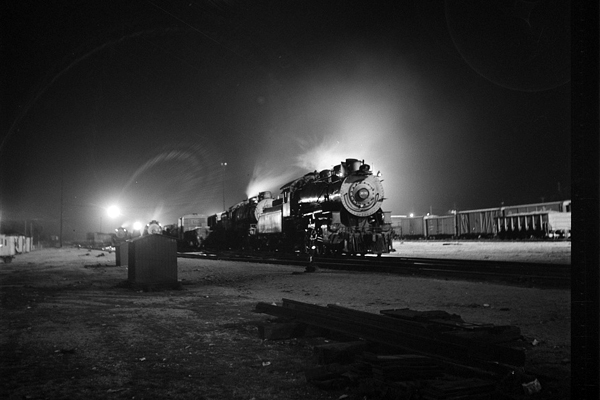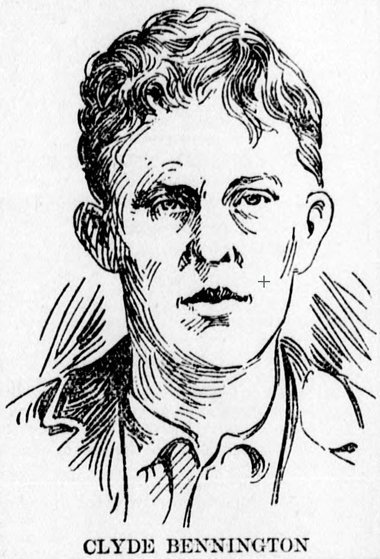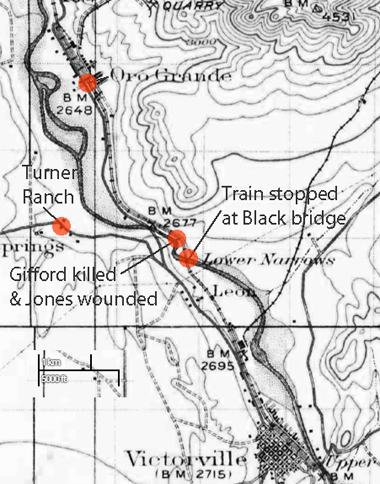The Oro Grande Train Robbery of 1898

Jack Delano photo LOC.
A train robbery near the Mojave River bridge at Oro Grande, California, on April 20, 1898, is an interesting tale of criminal misadventure, with acts of bravery and aftereffects. This incident, dealing with amateur robbers and a daring express messenger, became one of the most well-known of train robberies in the era teeming with violence, tragedy, and swift justice.
Setting the Stage
The westbound Santa Fe Overland No. 1 train was traveling through the empty parts of the Mojave Desert. The train's passengers and crew did not know the danger that was coming. As the train approached the Mojave River bridge, two masked men signaled for it to stop. These men were later recognized as Clyde Bennington, 19, and Paul "Toll" Jones, 23. They were young men with not much experience but big dreams.The robbers quickly boarded the locomotive, brandishing firearms to command control of the engine. Engineer Andrew W. Gifford and Fireman Charles Hicks were ordered to halt the train and assist in uncoupling the cars. The robbers forced the separation of the mail car, containing registered packages and valuable correspondence, from the rest of the train. The express car, however, remained attached, frustrating the bandits' plans to access the more lucrative Wells Fargo safe.
The Robbery in Action
With the engine and mail car now isolated, the robbers compelled Gifford to drive the train to a nearby siding. They rifled through the mail car there, stealing registered mail and valuables. Meanwhile, Express Messenger A.C. Mott, stationed in the express car, armed himself with a shotgun and revolver, preparing to defend the cargo. A towering figure known for his calm demeanor and expert marksmanship, Mott exemplified duty under pressure.The robbers, intent on returning for the express car, drove the engine back to the rest of the train. At this critical moment, Mott, along with Fireman Hicks and Car Inspector Clark, positioned themselves strategically to confront the attackers. As dawn broke, Mott spotted a masked figure armed and approaching. Believing him to be one of the robbers, Mott fired his shotgun, striking Jones and inadvertently hitting Engineer Gifford, who was being used as a human shield. Both men fell; Jones was mortally wounded, and Gifford was killed instantly.
Immediate Aftermath
The chaos and violence left the train's crew and passengers shaken. Jones, severely injured, was apprehended and taken into custody but succumbed to his wounds shortly after. His stoicism and refusal to confess left lingering questions about the full scope of the robbery. Engineer Gifford's death cast a somber pall over the incident, as he was widely respected and admired.Local law enforcement acted swiftly. Sheriff F.L. Holcomb, United States Marshal Pourade, and other officials formed a posse to track the remaining perpetrators. Their diligence paid off as they captured Clyde Bennington and two suspected accomplices, Lorenzo Haile and Albert Casner, within days of the crime. Haile, a saloon keeper in Oro Grande, and Casner, his nephew, and a local constable were implicated as the masterminds behind the plot.
Legal Proceedings
The legal consequences of the Oro Grande train robbery were very dramatic. Bennington, the youngest in the group, admitted involvement and gave evidence against Haile and Casner. Because he helped, he would get some leniency. First, he was given a life sentence for his part in the robbery; then, that was reduced to three years because he was young and had helped with the conviction of the older members of the gang.Haile and Casner were tried and convicted for their roles in planning the heist. Both received two-year sentences in San Quentin for conspiracy to defraud the government. The evidence presented at trial, including Bennington's detailed confession, painted a picture of two older men manipulating younger accomplices to execute their criminal scheme. Their complicity was laid bare despite their efforts to distance themselves from the crime.
The Human Element
The tragedy of Engineer Gifford's death weighed heavily on those involved. A.C. Mott, whose quick thinking and bravery likely prevented greater losses, was deeply affected by his unintentional role in Gifford's demise. The inquest exonerated Mott, recognizing his actions as justified and necessary to protect the train and its passengers. His reputation as a courageous and dutiful express messenger remained intact, but the emotional toll was significant.For Bennington, the robbery marked a turning point in his life. Described as a young man led astray by poor influences, he symbolized the dangers of youthful recklessness and the consequences of crime. His reduced sentence and eventual release underscored society's capacity for mercy and rehabilitation.
The Broader Impact
The Oro Grande train robbery highlighted the era's transportation systems' vulnerabilities and the risks those entrusted with valuable cargo faced. It also underscored the importance of security measures, such as arming express messengers, which became standard practice after similar incidents.The robbery also served as a cautionary tale about the allure of easy money through crime. Haile and Casner's roles as instigators and their ultimate downfall demonstrated that even those in positions of authority-Casner being a constable-were not immune to greed and poor judgment.
Legacy
Over a century later, the Oro Grande train robbery remains a compelling story of ambition, desperation, and justice. It offers a snapshot of the West's transition from lawlessness to modernity when railroads represented both progress and peril. The bravery of individuals like A.C. Mott and the swift action of law enforcement stand as testaments to the resilience of those who worked to maintain order in challenging circumstances.While the robbery brought tragedy and loss, it also demonstrated the enduring values of accountability and redemption. From a misguided youth to a man granted clemency, Clyde Bennington's story reflects society's capacity for understanding and forgiveness. The lessons of the Oro Grande train robbery continue to resonate, reminding us of the complex interplay between crime, justice, and humanity.



